Saline sodic - Study guides, Class notes & Summaries
Looking for the best study guides, study notes and summaries about Saline sodic? On this page you'll find 9 study documents about Saline sodic.
All 9 results
Sort by
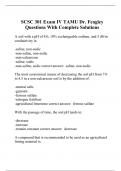
-
SCSC 301 Exam IV TAMU Dr. Feagley Questions With Complete Solutions
- Exam (elaborations) • 25 pages • 2023
- Available in package deal
-
- $14.99
- + learn more
A soil with a pH of 8.0, 10% exchangeable sodium, and 5 dS/m conductivity is: -saline, non-sodic -non-saline, non-sodic -non-calcareous -saline, sodic -non-saline, sodic correct answer: saline, non-sodic The most economical means of decreasing the soil pH from 7.0 to 4.5 in a non-calcareous soil is by the addition of: -neutral salts -gypsum -ferrous sulfate -nitrogen fertilizer -agricultural limestone correct answer: ferrous sulfate With the passage of time, the soil pH t...
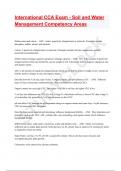
-
International CCA Exam - Soil and Water Management Competency Areas Exam Questions And Answers
- Exam (elaborations) • 20 pages • 2024
- Available in package deal
-
- $13.99
- + learn more
Define anion and cation. - ANS Anion: negatively charged atom or molecule. Examples include phosphate, sulfate, nitrate, and chloride. Cation: A positively charged atom or molecule. Examples include calcium, magnesium, sodium, potassium and ammonium. Define cation exchange capacity and anion exchange capacity. - ANS CEC is the amount of positively charged cations which can be held by a given weight of soil. Cations are held by negative charges in clay and organic matter. AEC is th...
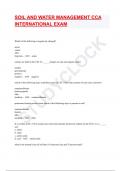
-
SOIL AND WATER MANAGEMENT CCA INTERNATIONAL EXAM QUESTIONS WITH VERIFIED SOLUTIONS
- Exam (elaborations) • 10 pages • 2024
-
- $12.99
- + learn more
Which of the following is negatively charged? anion cation AEC hyperion - ANS anion cations are held on the CEC by ______charges on clay and organic matter neutral gravitational positive negative - ANS negative which of the following clays contributes most to CEC if the same amount of each clay is present? montmorillonite hydroxyapatite illite kaolinite - ANS montmorillonite potassium fixation occurs when which of the following clays is present in soil? ...

-
Certified Crop Advisor Western Region Exam With 100% Correct Answers
- Exam (elaborations) • 25 pages • 2024
- Available in package deal
-
- $13.49
- + learn more
Certified Crop Advisor Western Region Exam With 100% Correct Answers Size of sand and its characteristics - answer.05mm to 2.0mm, lower CEC, lower water holding capacity Size of silt - answer.002mm - .05mm Size of Clay - answerless than .002mm Define bulk density - answerthe ratio of the mass of soil to its bulk volume. expressed in g/cm3 How does bulk density differ with soil texture - answersandy soil has higher bulk density because has less overall pore space. Bulk density ranges of...
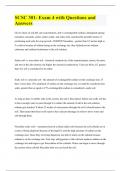
-
SCSC 301- Exam 4 with Questions and Answers
- Exam (elaborations) • 17 pages • 2024
- Available in package deal
-
- $7.99
- + learn more
SCSC 301- Exam 4 with Questions and Answers Given values of soil pH, salt concentration, and % exchangeable sodium, distinguish among nonsaline, nonsodic, saline, saline-soidic, and sodic soils, and describe possible means of reclaiming such soils for crop growth. ANSWER Nonsaline - greater than 8.5 and as high as 9 or above because of sodium being on the exchange site, they hydrolyze into sodium carbonate and sodium bicarbonate in the soil solution. Saline soil vs. non-saline soil - elect...
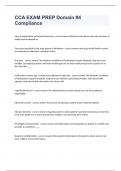
-
CCA EXAM INT. Study Guide 2023/2024
- Exam (elaborations) • 5 pages • 2024
- Available in package deal
-
- $12.99
- + learn more
Which of the following is negatively charged? a. anion b. cation c. AEC d. hyperion - correct answer a. anion Cations are held on the CEC by _______ charges on clay and organic matter. a. neutral b. gravitational c. positive d. negative - correct answer d. negative Which of the following clays contributes most to CEC if the same amount of each clay is present? a. montmorillonite b. hydroxyapatite c. illite d. kaolinite - correct answer a. montmorillonite Potassium fixat...

-
CRSS/ FANR 3060 EXAM 1 | QUESTIONS & ANSWERS (VERIFIED) | LATEST UPDATE | GRADED A+
- Exam (elaborations) • 19 pages • 2024
-
- $11.49
- + learn more
1 CRSS/ FANR 3060 EXAM 1 | QUESTIONS & ANSWERS (VERIFIED) | LATEST UPDATE | GRADED A+ soil Correct Answer: -layer(s) of generally loose mineral and/or organic material -affected by physical, chemical, & biological processes -usually hold liquids, gases and biota and support plants -non-renewable resource soil functions Correct Answer: anchorage for plants storage and recycling of nutrients regulate water supply habitat for many organisms engineering medium 2 transformations C...
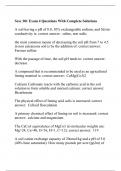
-
Scsc 301 Exam 4 Questions With Complete Solutions
- Exam (elaborations) • 5 pages • 2023
- Available in package deal
-
- $10.49
- + learn more
A soil having a pH of 8.0, 10% exchangeable sodium, and 5d/sm conductivity is: correct answer: saline, non sodic the most common means of decreasing the soil pH from 7 to 4.5 in non calcareous soil is by the addition of: correct answer: Ferrous sulfate With the passage of time, the soil pH tends to: correct answer: decrease A compound that is recommended to be used as an agricultural liming material is: correct answer: CaMg(Co3)2 Calcium Carbonate reacts with the carbonic acid in...
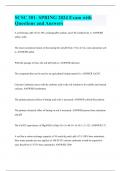
-
SCSC 301- SPRING 2024 Exam with Questions and Answers
- Exam (elaborations) • 9 pages • 2024
- Available in package deal
-
- $7.99
- + learn more
SCSC 301- SPRING 2024 Exam with Questions and Answers A soil having a pH of 8.0, 20% exchangeable sodium, and 5 dS conductivity is: ANSWER saline, sodic The most economical means of decreasing the soil pH from 7.0 to 4.5 in a non-calcareous soil is: ANSWER sulfur With the passage of time, the soil pH tends to: ANSWER decrease The compound that can be used as an agricultural liming material is: ANSWER CaCO3 Calcium Carbonate reacts with the carbonic acid in the soil solution to for...

How did he do that? By selling his study resources on Stuvia. Try it yourself! Discover all about earning on Stuvia


